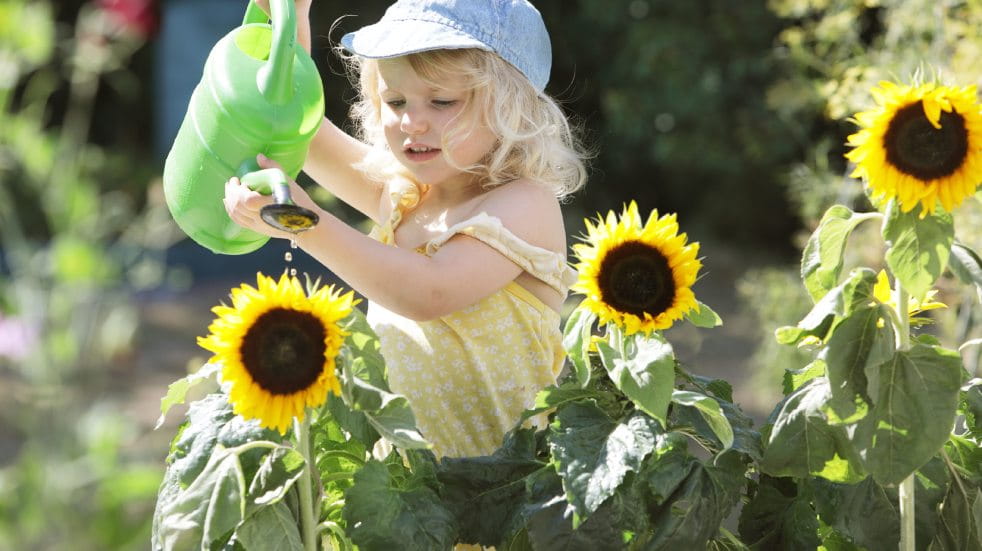
Sunflowers are easy to grow from seed, bringing a welcome burst of sunshine to even the smallest garden. Discover expert tips on planting and caring for them with our comprehensive gardening guide.
Cheerful, dramatic and wonderful for birds and insects, sunflowers (Helianthus annuus) make a joyful addition to the back of any flower border, a brilliant screen to an ugly fence, and a colourful backdrop to green beans, sweetcorn and tomatoes on an allotment. Garden designer and writer Francesca Clarke shares her top tips to help you grow your best sunflowers yet.
How to grow sunflowers
How long do sunflowers take to grow?

Young children will delight in sunflower growing/Credit: Getty Images
They’re often recommended as a starter project for young gardeners, and for good reason – they grow quickly and easily from seed, magically shooting upwards like Jack’s mythical beanstalk to reach heights of over 2 metres in a matter of weeks.
Toddlers to teens will enjoy pushing the plump seeds into pots of compost and checking on their progress each morning. And that might just spark a lifelong love of gardening.
Where to plant sunflowers
Annual sunflowers grow, flower, set seed and die all within one short season. And they need a lot of goodness to do all of that. This starts with a collection of 9cm pots filled with multipurpose compost, into each you press one seed, from the beginning of April (start off a handful every two weeks until June for a succession of flowers, July to October).
You can sow directly outdoors, but results are more unpredictable. Slugs and snails adore the young, fresh seedlings and can quickly hoover them up before you even notice them. If you want to give it a go, pop two seeds in each finger-deep hole, from late April into May. If both germinate, weed out the weakest.

Sunflower seeds can be harvested from plants at the end of each season/Credit: Getty Images
Indoors, cover your pots with a clear plastic bag and put them on a warm, sunny windowsill. Once green shoots appear, you can remove the bag. And when they’re sturdy little plants, begin the two-to-three-week ‘hardening off’ process of getting them used to outdoor conditions, a few hours at a time, building up to whole days spent outside.
Keep the soil just moist, pot them on into bigger pots as they grow and by late May or June you should have tough plants ready to plant outdoors (wait until they’re at least 30cm tall if slugs and snails are a problem in your garden).
Find gardening inspiration by joining Boundless Gardening Group.
How to care for sunflowers
Sunflowers are some of the greediest plants, so they need good, rich soil to grow tall and flower well. If yours is at all thin or sandy, improve it with generous spadefuls of well-rotted horse manure, garden or multipurpose compost. They’ll also need your sunniest spot.
By all means, grow them in containers on the patio or by the front door (though they probably won’t get as tall), but use roomy pots. Wherever you grow them, water as soon as they start to dry out and feed fortnightly with tomato feed. One last tip: staking taller varieties is a wise move – just tie them to bamboo canes with twine.
Follow these guidelines and you’ll have flowers from July, depending on the variety you’re growing. Of which there are many to choose from, including moody copper-red flowers, green-petalled cultivars and even white sunflowers. Dwarf varieties can be as small as 50cm, with others reaching over 2.5m. All are a draw for pollinators such as bees and butterflies.
How to harvest sunflower seeds
To harvest their seeds, once they’re plump and loose, the flowers have faded and the stems are browning, cut off the flowerhead and pop it on a sheet of newspaper indoors for a week or so.
You can them remove the seeds easily and store them in paper bags somewhere cool and dry. Remove the husks and use them in the kitchen or begin the sowing cycle again next spring.
If you’re leaving the seeds for the birds over winter, when the flowers are done and dusted, and the birds have finished feasting, try to resist the urge to cut them down. The sunflowers’ glamour may have faded, but their stems make great hibernation spots for insects, which will lend a hand in your garden the following year.
Do more with Boundless
If you're working in or retired from the public sector or civil service, Boundless has two great membership options to choose from: Boundless and Boundless Plus.
With Boundless, you get unlimited access or discounted entry to many of the UK’s top attractions including Kew Gardens and Wakehurst and WWT centres across the UK, as well as year-round deals on restaurants, holidays, shopping and much more. With Boundless Plus, you can enjoy additional benefits including unlimited access to Historic Royal Palaces sites, National Trust for Scotland places, access to the Ramblers' extensive group walks and routes, and peace of mind with roadside assistance and local recovery by LV= Britannia Rescue.





